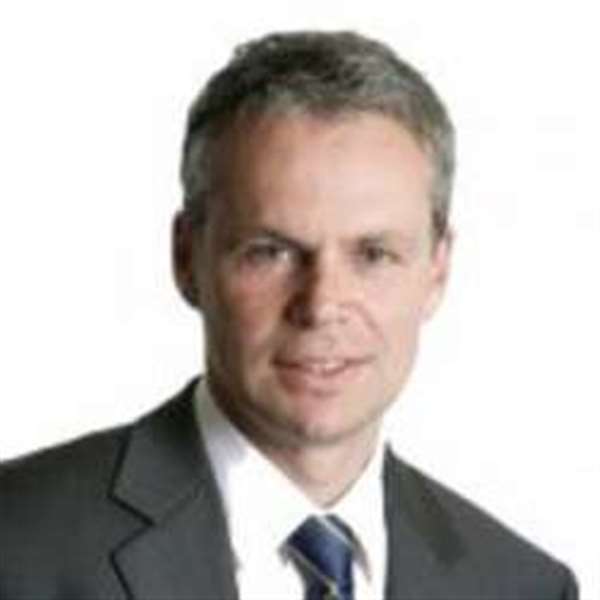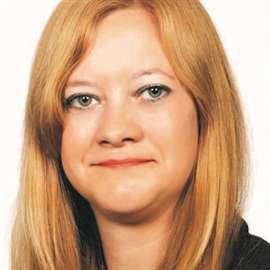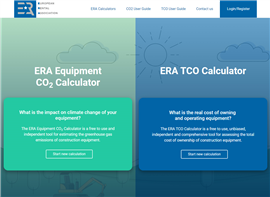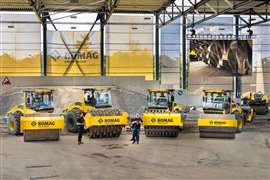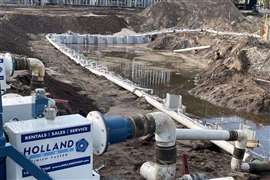“We’re only halfway”: Volvo CE CEO on electrification and what comes next
02 July 2025
“Where are we now in the industry? Are we really driving what we would call a transformation towards more sustainable solutions? That’s not my feeling,” says Melker Jernberg, president of Volvo Construction Equipment (Volvo CE), leaning forward in his chair, eyes widening slightly in frustration.
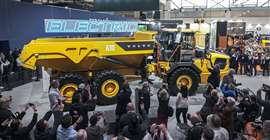 The Volvo A30 Electric was unveiled for the first time at Bauma 2025. Photo: Volvo CE
The Volvo A30 Electric was unveiled for the first time at Bauma 2025. Photo: Volvo CE
Construction Briefing sat down with Jernberg at Bauma Munich, Germany, for some relative calm in the midst of the world’s largest trade show.
Jernberg gives the impression of a man who does not rile easily and manages to retain the human touch, despite heading up a brand that last year had sales of approximately US$8.4 billion, placing it comfortably in the world’s top ten construction OEMs by sales.
For instance, towards the end of the interview the conversation turned to a customer event he was attending that evening and the lederhosen that he was wearing – when in Munich, and all that – but the subject of construction’s move to more sustainable solutions is one that he clearly feels passionate about.
Volvo CE has been a pioneer regarding electric construction equipment – if not the pioneer. The OEM announced all the way back in 2019 that it was stopping new diesel-powered versions of certain compact equipment in favor of electric machines and at Bauma 2025 showcased only electric machines.
“I think we can clearly say that, in the global players, we are the outstanding leader when it comes to an electric portfolio,” says Jernberg. However, interestingly, he admits that, in some cases, the shift to electric may have gone too quickly and is also keen to stress that Volvo CE doesn’t see there being just one power solution in the future.
The benefits of hybrid power
Using the example of the automotive industry, he says that hybrid was the option that made the most sense, so vehicles could use diesel power on highways and electric in the cities. “That would’ve been a super good step. Instead, we say, okay, let’s change the whole world and let’s go 100% battery electric. So, of course, now we see the backlash of that,” he says with a wry laugh.
Jernberg says that internally they had a discussion: could they really afford to place their bet on one power solution? And did they really think that in the future there would be just one power solution? The answer to both questions was a resounding no.
“We said that we really believe when it comes to heavy trucks and construction equipment, that battery electric will be one solution and we also absolutely believe in the future for the combustion engine. Then we started to innovate and invest in optimising engines,” he says.
Volvo CE has also entered a joint venture with Daimler Truck and created the company CellCentric which develops fuel cells, including hydrogen. “We have the luxury being in such a company, that we don’t need to make the bet now [on one power source]. Because it’s super risky to play with a hundred-year history [of the company]. At some points in time, you need to take tough decisions, but if you’re not forced to take a decision too early, you should wait.”
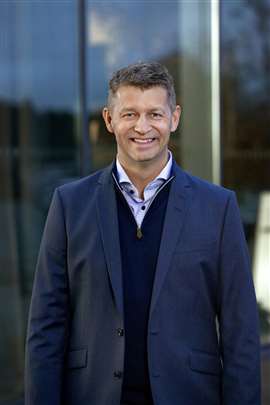 Jernberg has been President of Volvo CE since 2018. Image: Volvo CE
Jernberg has been President of Volvo CE since 2018. Image: Volvo CE
New equipment launch
At Bauma Munich, Volvo CE launched what it claimed are the world’s first battery-electric articulated haulers of their size class, including the premiere of the A30 electric articulated hauler. It will be available to rent, alongside the larger A40 Electric, for select customers in some European markets in 2026.
The launch of two such large machines feels significant – thus far, most electric-powered machines that have been launched have been compact. However, there can be an issue of electric compact equipment not getting enough hours of use to provide a payback on the high purchase price, as well as it typically being used in applications where charging can be a problem.
Reminiscing about the iteration of the electric haulers, Jernberg reveals that, initially at least, they were not going to proceed with the project for what sounds like a fairly water-tight reason: the engineering team said that it was not possible.
“Internally it was not easy to decide that we should even do the machine. With the reason, from an engineering perspective, it was not possible. That was the starting point,” he says, clearly enjoying the memory. “But then the decision was that’s the reason we should do it. And then, of course, there were some debates, and because it’s a new model you need to see things from another angle.”
Does Jernberg see the launch of the large electric haulers as a sign that, in the future, the trend may be towards larger equipment being powered this way?
“Yes. Our strategy was to start with the small machines,” he confirms. “That was more because technology-wise, that was what was possible to do at that time. Now we’re moving from small to medium to large and heavy. Using knowledge, the development of battery technology, but also everything else you need. You can say that, in that pyramid, we are halfway.”
One of the issues with electric equipment is its high cost. Companies will point to the total cost of ownership over the course of the life of equipment being competitive and, of course, the cost of electricity is significantly cheaper than that of diesel but if the purchase point is double the price – or more – that will be an obstacle.
Jernberg says that the cost, “has already has come down and I think it’ll continue to come down,” but acknowledges that it is an issue. “For some applications it is still too high a difference, we must be fair and say this.” However, he adds that there are lots of applications where it makes sense financially to use electric equipment, as well as the other benefits such as less CO2 and noise.
Growth opportunities
 Volvo CE has an extensive electric equipment portfolio. Image: Volvo CE
Volvo CE has an extensive electric equipment portfolio. Image: Volvo CE
Sweden-based Volvo CE are well established around the world, particularly in Europe and North America. Jernberg says that they are increasing their knowledge of South America but highlights Asia as the geographic area with the strongest growth opportunity for the OEM.
“If you can manage to be competitive as a player in Asia, I think that is underestimated as potential. We are good in Asia, but not in all of Asia. It’s a different business, almost a different business model. It’s not the same as Europe and North America. So, we’re focusing on that. That could be an upside for my competitors as well, I realise,” he says with a knowing smile.
The OEM recently announced that it had signed a contract to sell its ownership in China-based SDLG (Shandong Lingong Construction Machinery Co) to a fund predominantly owned by the Lingong Group (LGG).
Volvo CE acquired a majority stake in SDLG in 2006, with LGG as a minority shareholder. Jernberg says that the decision was made as Volvo CE plans to focus on offering Volvo-branded premium products and services to focused customer segments in China and utilise its system in China as a production centre serving both the domestic and export markets.
Electric equipment is a relatively small part of the OEM’s portfolio, but the subject comes up again when speaking about growth potential for the future, as it fits into the bracket of sustainable solutions.
“I see a lot of opportunities as we move into much more sustainable solutions, because that’s a must. We need to do that. That’s why I’m disappointed about 2025 because we, as an industry, we don’t try hard enough. The combination of the need to improve productivity with sustainable solutions is there, and digitalisation brings lots of upsides.”
Driving sustainable solutions
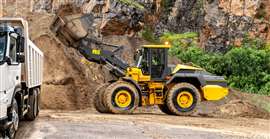 Sales of electric equipment have stagnated, but Jernberg believes they will recover. Image: Volvo CE
Sales of electric equipment have stagnated, but Jernberg believes they will recover. Image: Volvo CE
The adoption of electric equipment has clearly not accelerated as quickly as Jernberg would have wished.
When asked about the potential future sales of electric machines, he takes the paper with Construction Briefing’s questions for him, flips it over, and sketches a graph from 2018 to 2035 and a line showing the rate of sales of electric equipment.
“Now we are in a flat period, but it will not continue like this. It’ll come back. My hope is if we meet at the next Bauma, in three years, that we come to a point in time where we are extremely surprised about the speed of adoption,” he says.
“And that could be in 2028. I hope we are overwhelmed about the speed that we suddenly realised that we could do it in the industry. Maybe we would be surprised about that speed, because now we are a little bit worried about this bump. If this happened, then everyone will realise that we should have started earlier. That’s the dream.”
Time will tell whether this dream becomes a reality and, while the issue of electric equipment is obviously close to the heart of Volvo CE’s President, the OEM is clearly also investing heavily in combustion engines and other power sources, such as hydrogen. Construction Briefing’s time with Jernberg comes to an end, and he immediately leaps up to share a joke with a colleague.
As the conversation ends, Jernberg heads off to his next appointment and, presumably, to get ready for his customer night in traditional Bavarian dress code. His passion for sustainability is clear, as is his enthusiasm for personal relationships in the construction industry. “Even if it’s business to business,” he says, “this is person to person.” In an industry still wrestling with how best to become more sustainable, personal connections could be vital in helping to drive that change.
STAY CONNECTED



Receive the information you need when you need it through our world-leading magazines, newsletters and daily briefings.
CONNECT WITH THE TEAM
